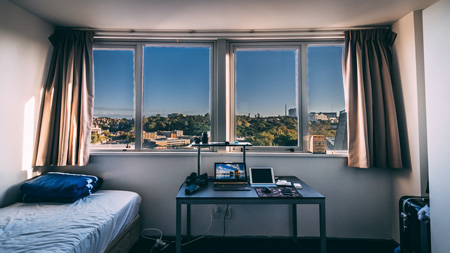Stain Fighting Tips for Curtains and Drapes
Most stains are removed by dissolving them with a solvent. The solvent to use depends from two factors: the agent that is causing the stain, and the material that has been stained. Different solvents will dissolve different stains, and the application of some solvents is limited by the fact that they not only dissolve the stain, but also dissolve the material that is stained as well.
Another factor in stain removal is the fact that stains can sometimes comprise two separate staining agents, which require separate forms of removal. A machine oil stain could also contain traces of metal, for example.
Also of concern is the color of the material that is stained. Some stain removal agents will not only dissolve the stain, but will dissolve the dye that is used to color the material.
Avoiding setting stains
If a stain has "set", it has become chemically bonded to the material that it has stained, and cannot be removed without damaging the material itself. It is therefore important to avoid setting stains that one wants to remove. This can be done by avoiding heat (by not pressing or ironing the stain), sponging stained materials as quickly as possible, using the correct solvent (some do not act as solvents on all stains but on some stains as catalysts that will cause the stain to set), and avoiding rubbing the stain.
First rule of stain removal, MOVE FAST. The longer stains have to set, the less likely they can be safely removed and the higher the chance of permanent color change, even if all the original stain material is removed. Immediately blotting (not rubbing) the stain material as soon as possible will help reduce the chances of a permanent color change. Identify the proper technique for your stain, and take action NOW.
Drapes and Curtain fabric is not meant to be washed like clothes are. Even light contact with too much liquid can cause damage to the fabric fibers, color, and shape of your drapes. Remember, when it comes to treating stains, LESS IS MORE. Always try the least invasive techniques first, and use gradually more aggressive techniques until the stain is gone.
Stain By Stain Removal Guide:
Adhesive Tape Residue:
Harden the sticky surface with ice in a plastic bag and scrape any residue with a dull knife. Blot spots with acetone nail polish remover. If spot remains, treat with carpet cleaner.
Beer:
Sponge up excess liquid. Saturate affected part with one-to-one solution of distilled white vinegar and water. Blot area with a cool, damp towel. If discoloration remains, treat with a carpet cleaner.
Fruit Juices:
Wipe up excess residue. Blot with mild laundry detergent and warm water. Rinse spot with one-to-one mixture of white vinegar and water, blot again with mild detergent and water, then sponge clean with cold water.
Grape Juice:
Blot up excess liquid with a paper towel. Pour club soda on the stain and let it sit for five minutes. Blot the stain with a white towel until no more color appears on the towel. Sponge with cold water to rinse.
Blood:
Blot stains with cold water continuously until it disappears. If that doesn’t work, try treating it with a carpet cleaner. Treat dried stains with a small amount of glycerine; let stand for 30 minutes, then blot with water.
Candle Wax:
Allow wax to harden completely, then scrape off as much as possible. Place a flattened brown paper bag over the remaining stain and press with a warm iron until the wax melts into the paper. Move the bag around to prevent excess wax from transferring back onto the fabric.
Chewing Gum:
Apply a plastic bag of ice cubes to the chewing gum until it hardens. Carefully remove the hardened residue with a dull knife. Clean any remaining residue or stain with a carpet cleaner.
Chocolate:
Allow melted chocolate to harden and then scrape off with a dull knife. Blot stain with a mixture of mild detergent and warm water.
Coffee:
Blot the stain with paper towels, then spray a one-to-one solution of water and distilled white vinegar. Blot, then apply a mixture of liquid dish soap and water. Blot again and rinse with cold water.
Crayon:
Remove excess crayon with a dull knife. Apply rubbing alcohol to the stain until no more color is transferred to the towel.
Grass
Pour a small amount of mild laundry detergent onto the stain and let it stand for two hours. Blot the soap away using a damp towel.
Grease:
Dab with a small amount of liquid laundry detergent; let it stand for a few hours. Scrub clean with a small brush. Wipe any residue with a damp white towel
Ink:
Press a paper towel to the stain to remove as much as possible. Apply rubbing alcohol and blot. Move fast, the longer the curing time, the more it will set permanently.
Ketchup:
Make a thick paste of borax and water. Apply directly to the stain and allow it to sit for 30 minutes. Wipe the paste away and blot with a damp towel.
Lipstick:
Wipe away excess lipstick. Wet the stain with a small amount of rubbing alcohol. Blot with a white towel until no stain is transferred to the towel. Treat with a carpet cleaner if a blemish remains.
Milk:
A forgotten milk spill can leave a smell that is very difficult to remove. Dab fresh stains with a sponge and warm water, then apply a carpet cleaner.
Mustard:
Immediately scrape away any residue. Blot the stain with a few drops of white vinegar; let the vinegar sit for a few minutes, then blot with cold water to rinse.
Nail Polish:
Blot with a white towel dipped in rubbing alcohol. Apply a carpet cleaner to any remaining spot.
Paint (latex):
Wipe or scrape away any excess paint. Mix a teaspoon of mild laundry detergent with warm water and blot. Rinse by blotting the spot with clean water. If any discoloration remain, apply a carpet cleaner. If the paint has dried, try treating it with a water-soluble paint or varnish remover.
Paint (oil):
Wipe away excess paint (or scrape away paint with dull knife). Use white towel moistened with rubbing alcohol to blot the stain until no more color shows up in the towel.
Pencil:
Surprisingly, try a pencil eraser, blow off residue, repeat as required.
Perspiration:
For fresh stains on textiles, sponge with warm water. If there is still discoloration, cover the damp spot with talcum powder, let it sit for a few minutes, then brush away using a soft cloth.
Rust:
Cover the stain with lemon juice, then sprinkle with salt. Let the mixture stand for an hour, then sponge off with clean water.
Tea:
Blot fresh stain with a paper towel and then sponge with warm water. Treat the spot with a bit of carpet cleaner.
Tomato:
Remove any excess residue with a paper towel. Apply a small amount of rubbing alcohol to the stain and blot with a white towel until no more color is transferred to the towel.
Urine:
Blot with paper towels to remove as much liquid as possible. With a sponge, apply a solution of one quarter cup vinegar, a teaspoon of liquid dish soap, and several drops of eucalyptus oil. Let the mixture stand for 20-30 minutes, then blot using again a clean, damp towel.
Vomit:
Wipe up any remaining residue. Sponge with a mix of laundry borax and water, then with cold water. Treat any remaining stain with carpet cleaner.

